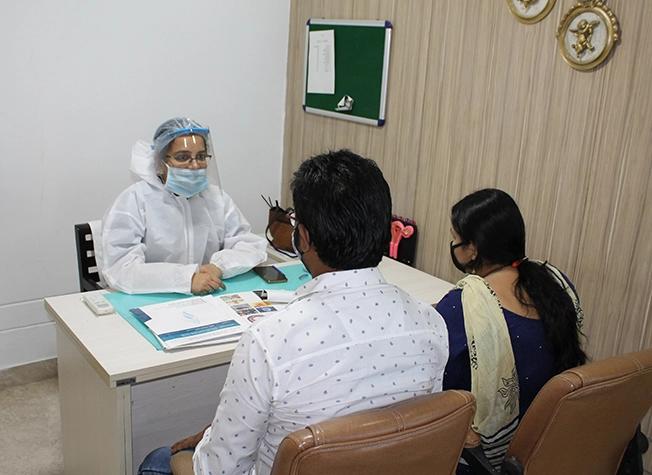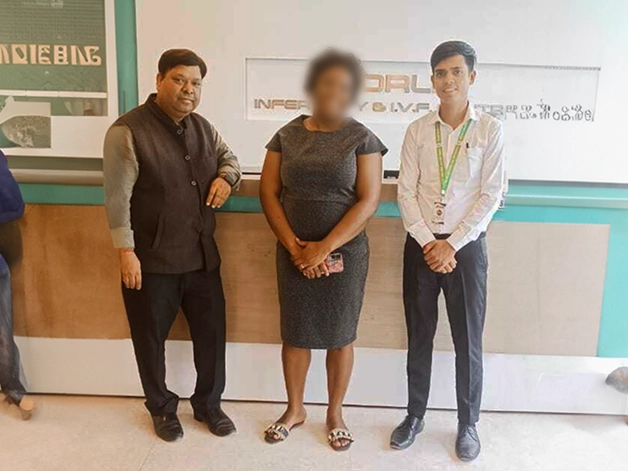
Easy Monthly Installment
@ Just ₹4,611/-*
Per Month

A blastocyst is an embryo developed in suitable laboratory settings for five days after the insemination process. They have a fluid-filled central cavity that contains two types of cells. The inner cell mass of the blastocyst gives rise to the fetus after implantation, and the outer layer of the cell gives rise to the placenta.
"In this technique, the embryo is developed in the laboratory and is placed in the womb. The embryos developed for four to five days are more advanced than the ones developed in three days, and they are termed as a blastocyst. This technique allows embryologists to select more advanced embryos that enable better chances of implantation."
The procedure uses a culture media that mimics the changing environment of the reproductive tract and meets the unique environment of the embryo as it travels the fallopian tube. This technique enables the embryo to grow successfully till the blastocyst stage, and these blastocyst embryos are transferred to the woman's uterus on the day five. It is the best option for the couple who have unsuccessful IVF or ICSI treatment even after having good quality eggs. The blastocysts transfer technique enables them to have more viable embryos for implantation and transfer, which helps achieve a more successful pregnancy.
Blastocysts have a better chance of implantation, as they are more developed than other cells and have a higher probability. It also has a thin outer layer shell, which increases the chance of implantation into the uterine cavity.
This embryo is cultured in vitro for five days until it comes to the final stage of the embryo development or blastocyst, and then it is implanted into the uterine wall. The embryo at this stage has higher pregnancy rates. This also enables the specialist to choose the best embryo that increases the implantation rate. This also enables specialists to exchange fewer blastocysts and diminishes the likelihood of possibly dangerous twin or triplet birth.
For more information about Blastocyst Culture and Transfer treatment in Delhi visit today at World IVF Center.
A blastocyst is an embryo developed in suitable laboratory settings for five days after the insemination process. They have a fluid-filled central cavity that contains two types of cells. The inner cell mass of the blastocyst gives rise to the fetus after implantation, and the outer layer of the cell gives rise to the placenta.
"In this technique, the embryo is developed in the laboratory and is placed in the womb. The embryos developed for four to five days are more advanced than the ones developed in three days, and they are termed as a blastocyst. This technique allows embryologists to select more advanced embryos that enable better chances of implantation."
The procedure uses a culture media that mimics the changing environment of the reproductive tract and meets the unique environment of the embryo as it travels the fallopian tube. This technique enables the embryo to grow successfully till the blastocyst stage, and these blastocyst embryos are transferred to the woman's uterus on the day five. It is the best option for the couple who have unsuccessful IVF or ICSI treatment even after having good quality eggs. The blastocysts transfer technique enables them to have more viable embryos for implantation and transfer, which helps achieve a more successful pregnancy.
Blastocysts have a better chance of implantation, as they are more developed than other cells and have a higher probability. It also has a thin outer layer shell, which increases the chance of implantation into the uterine cavity.
This embryo is cultured in vitro for five days until it comes to the final stage of the embryo development or blastocyst, and then it is implanted into the uterine wall. The embryo at this stage has higher pregnancy rates. This also enables the specialist to choose the best embryo that increases the implantation rate. This also enables specialists to exchange fewer blastocysts and diminishes the likelihood of possibly dangerous twin or triplet birth.
For more information about Blastocyst Culture and Transfer treatment in Delhi visit today at World IVF Center.
In vitro fertilization (IVF) is a common assisted reproductive technology used to help couples or individuals conceive when natural conception is challenging or impossible. The IVF procedures involve multiple steps- Ovarian Stimulation, Egg Retrieval, Sperm Collection, Fertilization, Embryo Culture, Embryo Transfer, Luteal Phase Support, Pregnancy Test & Embryo Cryopreservation. IVF has offered hope to many individuals and couples facing fertility challenges and has resulted in the birth of numerous healthy babies at our IVF Clinic in Delhi.
Are you struggling with infertility and not being able to conceive for a long time? Don't worry! Experience the joy of parenthood with IVF at World Infertility & IVF Centre, Delhi, India.
Our Empanelment
Neelkanth Hospital is a leading super multi-speciality hospital, nestled in Gurgaon. With 70+ years of legacy in healthcare, 42+ years of experience in the specialised field of infertility treatments, we provide modern medicine and medical procedures with the latest technology.
IVF Success Stories
What our patients say about us

We are delighted to announce that our doors are open, and we are now accepting appointments to serve you better.